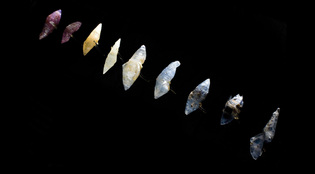 loading
loading
Last LookBling, in the rough Julie BrownView full imageNew York City gem dealer Benjamin Zucker ’62 has an eye for fine jewelry. But he has never considered submitting these nine uncut sapphires, each about an inch and a half long, to the lapidary. Zucker says he bought the sapphires—now on display at the Peabody Museum—in the mid-1970s "for their educational value." As a group, this spectrum in crystal shows the wide range of colors that traces of iron, titanium, and chromium can produce in sapphires. Every sapphire is a variety of corundum, a form of aluminum oxide that crystallizes under tremendous heat and pressure. If, however, the corundum contains traces of chromium only, the result is called a ruby. Alternatively, if the heat and pressure aren't quite right for creating precious stones, the result is garden-variety aluminum oxide crystals. They make a very good sandpaper.
The comment period has expired.
|
|